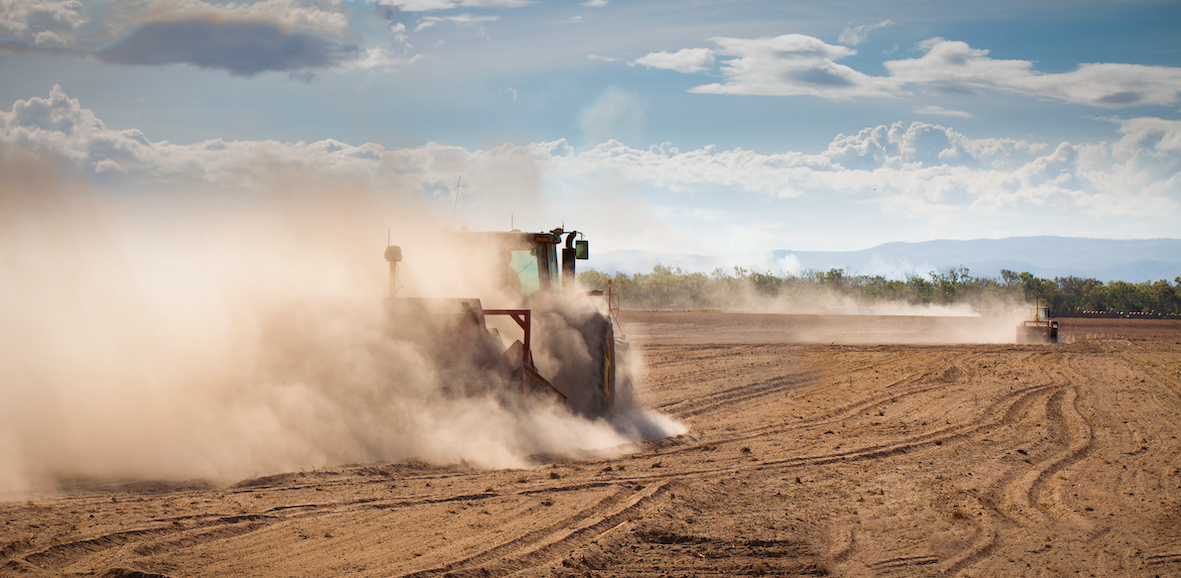- The agricultural sector is perhaps the most vulnerable to climate change.
- Change in temperature, rainfall and extreme weather can affect yields, and the prevalence of pests and diseases.
- If temperature rises too much, certain crops will be unable to grow on existing land… but others might!
Agriculture and Climate Change
With almost all its inputs coming from nature, the agricultural sector is perhaps the most vulnerable to climate change. A recent report from the Intergovernmental Panel on Climate Change (IPCC) showed that climate change is already affecting every inhabited region around the world. Since the 1950s, almost every region in the world has observed an increase in the prevalence of hot extremes. Many in Europe, Asia, North America, and South Africa have observed an increase in heavy precipitation while others in the regions have experienced an increase in agricultural and ecological drought.
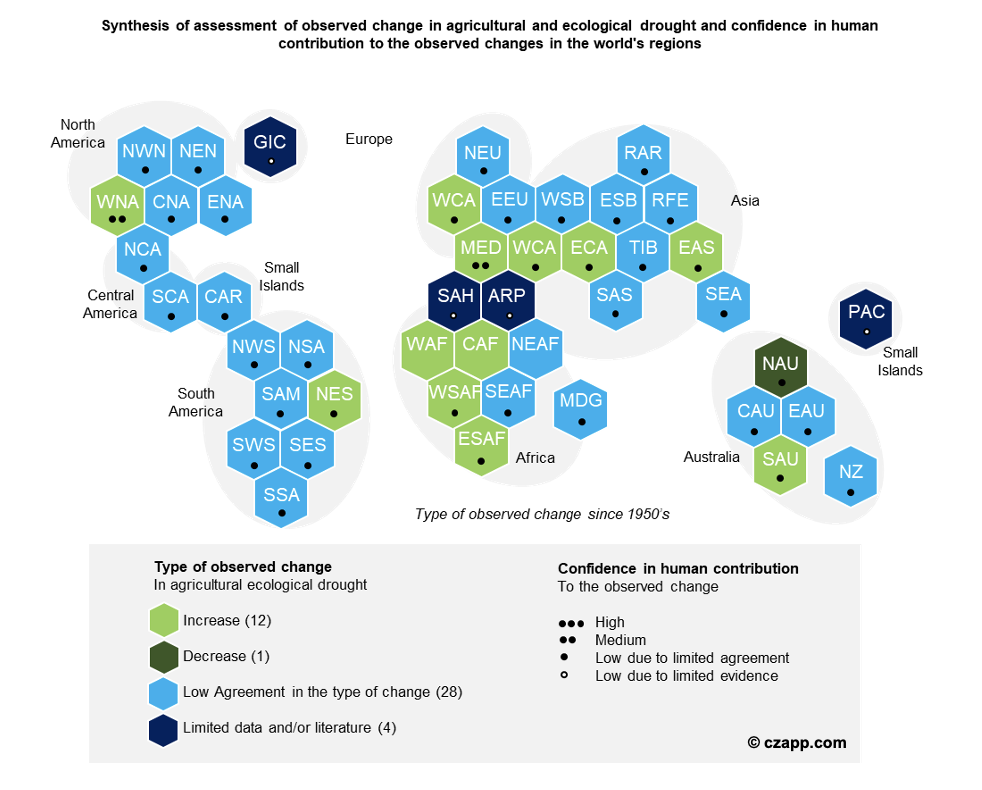
The IPCC says that with further global warming, these events are likely to become more common as the temperature of the planet continues to increase. An agricultural or ecological drought that would have occurred once every 10 years in the late 19th century now likely occurs 1.7 times, and with a temperature rise of 4°C is likely to occur 4.1 times.

Already, we’re seeing the impacts of climate change at work in agriculture. The change in temperature, rainfall and extreme weather events can affect yields and the prevalence of pests and diseases. If temperature increases too much, certain crops will be unable to grow on existing land as optimum temperatures are exceeded. In the US, the impact of extreme weather events on yields from 1960 to 2010 can be seen in the chart below.

In Brazil, agricultural productivity has been impacted by drought and frost, particularly this year and there are concerns over its impact on sugar supply. Taiwan also suffered its worst drought in 56 years during 2021. In some cases, farmers reported being cut off completely from the water supply to preserve the resource for the country’s semi-conductor industry. And recent wildfires across Greece have been attributed to the consequences of climate change by the World Meteorological Organization.

Innovation in Agriculture
Agriculture as we know it is changing, but this isn’t necessarily a bad thing. With adversity comes innovation. And as long as we continue to farm sustainably in addition to taking steps to mitigate climate impact within the industry, there’s no reason why agriculture cannot adapt to the changing weather patterns.
For example, in the UK, the temperature has been warming gradually and the country now experiences much more temperate winters and hotter summers. In Southeast England, the maximum winter temperature reached as high as 9.6° Celsius in 2020, up from 6.1° Celsius in 1965. Over the same period, autumn, spring, and summer maximum temperatures in the region have risen by about 2-3° Celsius.
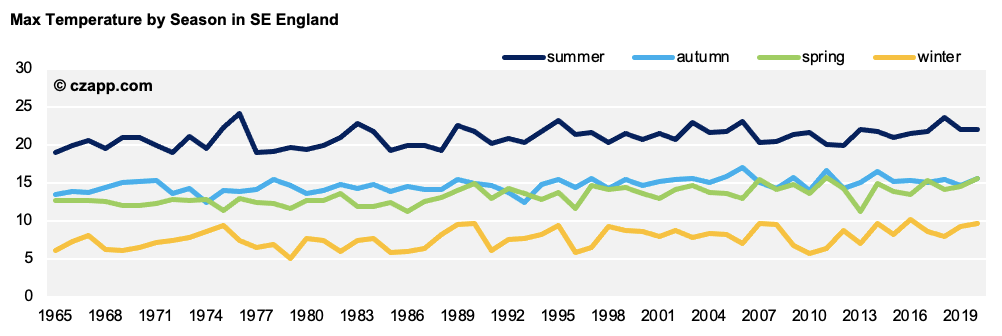
This allows the region to grow the kind of produce that was previously unthinkable. According to data from WineGB, the total area under wine production in the UK has increased exponentially to 2,138 hectares in 2018 from 652 hectares in 1989, thanks in large part to the more temperate climate.

As UK temperatures rise enough to accommodate wine growing, temperatures in Mediterranean countries are becoming too hot for the industry. In response, farmers have begun to shun grapes in favour of tropical produce such as kiwis, mangoes, avocados, and bananas.
According to data from Eurostat, land area used for cultivation of fruits from subtropical and tropical climate zones has increased since 2015 from 137,550 hectares in 2015 to 149,550 hectares in 2020. Cultivation of tropical and subtropical fruits in Spain has increased by 11,000 hectares in the period to 76,450 hectares and both Greece and Portugal have increased land under cultivation by about 2,000-3,000 hectares.
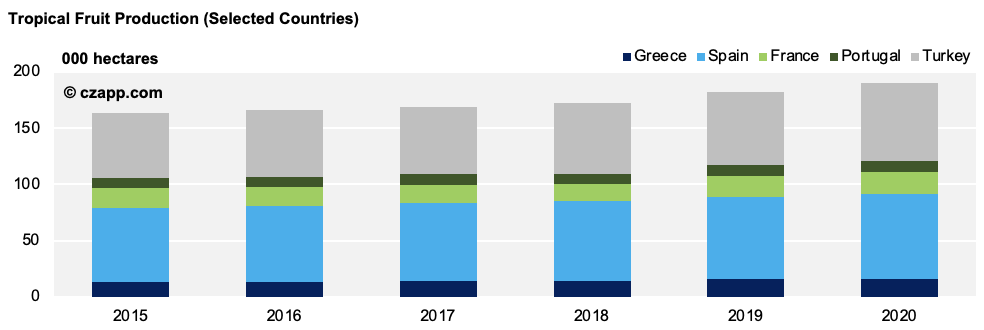
If you live in Europe, the chances are that the bananas you buy don’t come from the Caribbean but from Spain, where 60% of European-consumed bananas are grown. Not only is that good for Spain’s agriculture industry but also for the planet, given the lower emissions that will be emitted during transport.
The following map shows modelling of potential future agricultural areas. The areas in blue represent those where there is no current cultivation but for which climate change will present the possibility to cultivate at least one major commodity. The red areas represent regions where the cultivation of multiple major commodities will be possible.
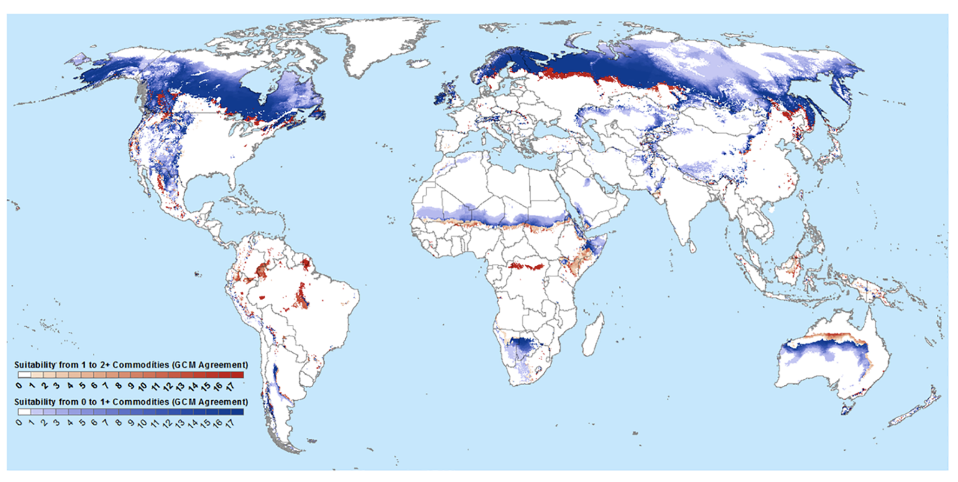
Source: PLOS Journals
And some features of a warmer climate may be welcome to some farmers. In a study published in Nature Climate Change, researchers projected that risk from diseases would decrease in tropical countries as the climate warms.
However, the other side of the coin is that yields will also stall in conjunction with a decreased risk of pests. This is not good news, especially since a huge question that faces the industry today is how to increase yields while farming sustainably, moderating pesticide and water usage, and reducing greenhouse gases.
As should be expected, agricultural yields in absolute terms have been increasing over the years hand in hand with the spread of cropland.

But when adding the growing population into the equation, the picture changes slightly. On a per capita basis, yields have been relatively flat over the last 20 years and have dipped since the 1970s.
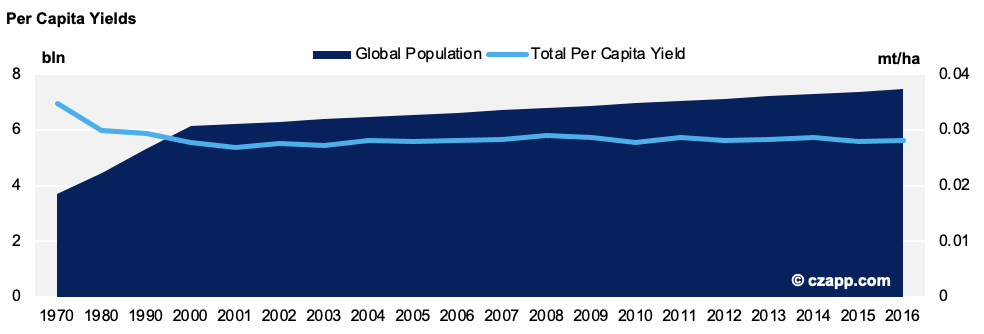
Obviously, in the name of sustainability (and physics), agricultural land area cannot be expanded infinitely to yield more for a burgeoning population, so what should the industry do? The first step is to continue addressing the losses typically experienced in agriculture.
Within the sugar industry, the 1960s saw losses as high as 51% of attainable yield. This has been steadily decreasing as new technologies and greater efficiencies are introduced, but the yield gap remained at about 15% of attainable yields in 2018.

As well as increasing yields, farmers (and the rest of the supply chain) need to minimize losses. One way that yields are lost is during cultivation to pests. There are huge variations in estimates on a regional level and on a year-by-year basis, but the FAO says on average around 14% of the world’s food is lost between harvest and retail.
Several solutions have been developed over the years, the most fundamental being pesticides. Now, with concerns surrounding the environmental and health impacts of these chemicals, other ideas have been developed, including synthetic fertilizers, integrated pest management and in some cases alternatives to pesticides. We write at length about this in our Sustainable Agriculture series.
Studies have found that soil degradation, monoculture, heavy machinery, and excessive tillage are among the factors that reduce cane yields after the first harvest. This is where regenerative agriculture can play a role.
The premise of regenerative agriculture, rather than causing no harm to soil, is to improve its quality while farming. The practice incorporates organic farming, conservation tillage, cover crops, crop rotation and composting among other actions. According to studies, every 1% increase in organic soil matter helps it hold up to 20,000 gallons more water. So not only does it improve the quality of the crop, but it also preserves resources.

After cultivation comes harvest, and losses during this process have largely been combatted by increased use of technology and mechanization. Like in all things, human error and fatigue can always play a role in farming and machines are just that bit more precise and efficient. Those in the agriculture industry then need to consider losses incurred during transportation.
Scientific Breakthroughs
Science is making huge breakthroughs to help farmers increase yields while still farming sustainably. Perhaps the most intriguing option is gene editing, which is still in its infancy but already showing promising results. Much like choosing the modifications on a new car, the technology can modify the genetic makeup of crops to input a number of desirable characteristics. These can include, but are not limited to, resistance to pests, resilience to extreme temperatures and lower water requirements. The technology can also remove unwanted genes.
This technology is promising and could be the answer the agricultural industry was waiting for. But there are still many hurdles to overcome, including regulation, public mistrust, and as yet potentially unknown environmental and health risks. China is relying heavily on CRISPR technology to feed its growing population and several countries such as the USA, Brazil, Argentina, and Japan have exempted CRISPR from regulations that apply to Genetically Modified Organisms (GMOs). Both the UK and Europe are reviewing their stances to CRISPR-modified crops, which could signal a new opportunity for the agricultural industry.

Source: Vox
Researchers from the Center for Advanced Bioenergy and Bioproducts Innovation (CABBI) at the University of Florida announced this month that they had successfully began the process of editing the sugarcane plant’s genome to change its appearance and to reduce its resistance to herbicides. The next step, says the team, is targeting select genes within the crop to increase biomass, lipid production and fatty acid production with a goal of increasing productivity.

Other Opinions You Might Be Interested In…
- Why Are Sugar Specs Bucking the Trend in Soft Commodities?
- Sustainable Agriculture: Alternatives to Pesticides
- Sustainable Agriculture: Pest Control

